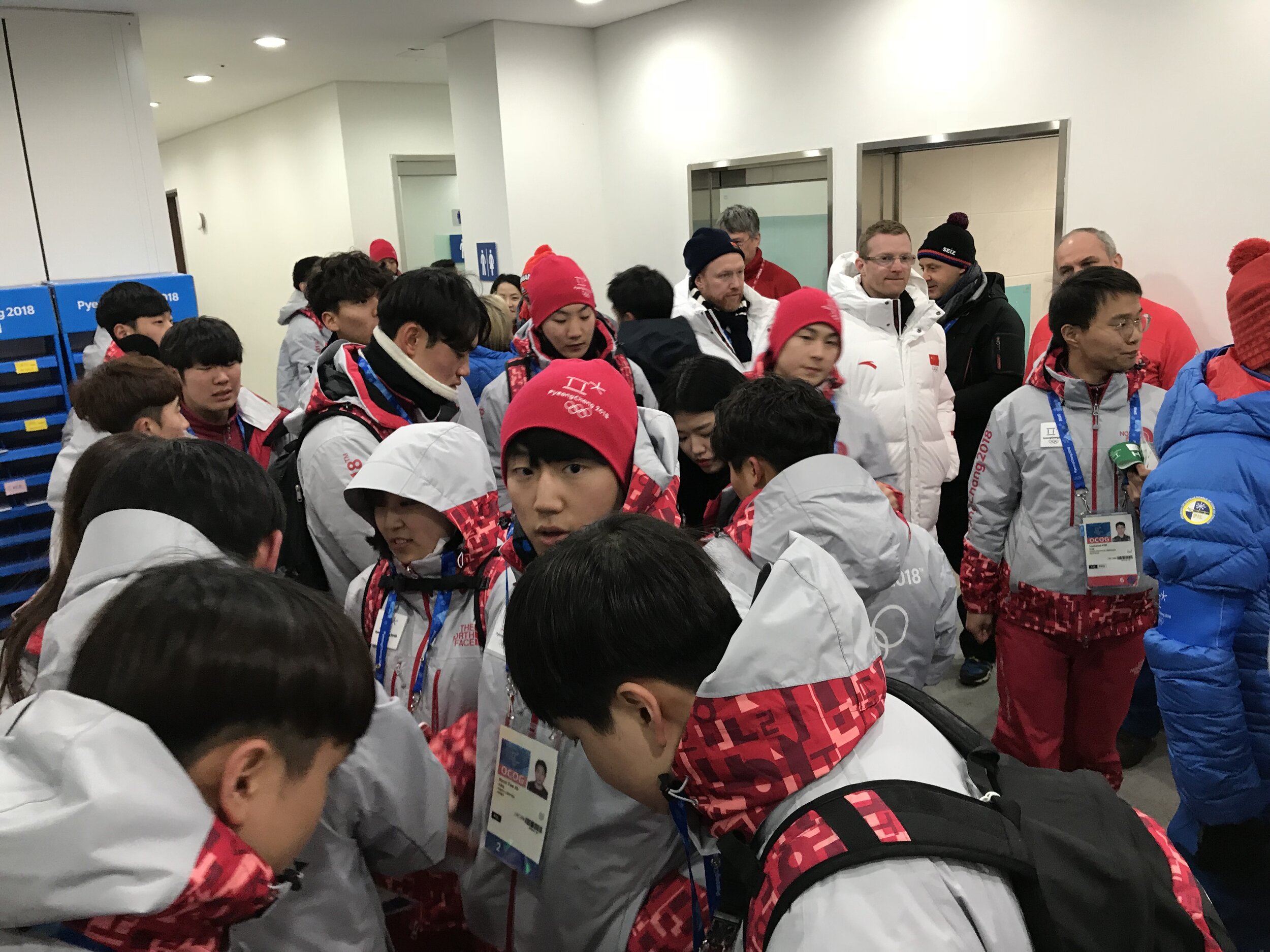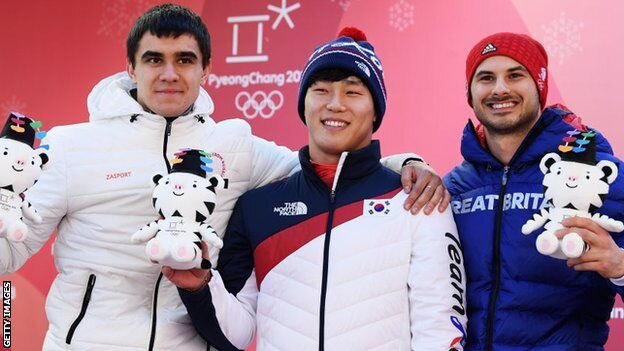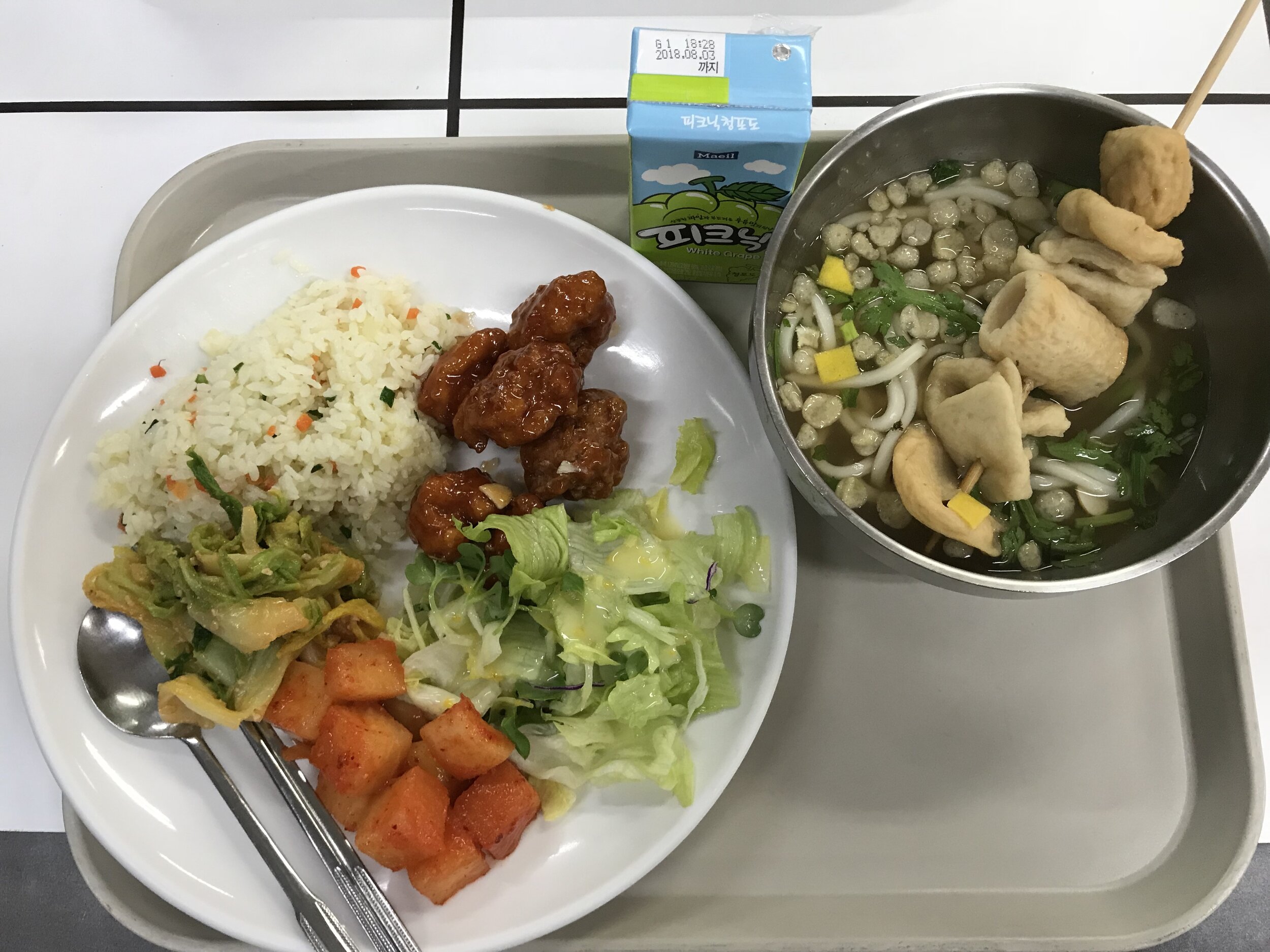A Day in the Life of an Olympic Volunteer
My day as a volunteer at the Pyeongchang Olympic Sliding Centre
Friday, February 16, 2018
4:30 a.m. — Rise and prep for the day
Today we will work at the final heats for the Men’s Skeleton.
4:30 a.m. is particularly rough today because we only got in the night before at 1:00 a.m. — after volunteering at the Luge Relay Team competition. But I can already feel the energy and excitement of the volunteers.
Today’s competition is a big deal.
Korea’s favorite son, Sungbin Yun, will compete for the gold in Men’s Skeleton. They call him “Ironman” here.
Every Korean wants to see him in person.
5:10 a.m. — The Passion Crew boards the volunteer shuttle bus
All the volunteers at the Pyeongchang Winter Olympics are called the Passion Crew — and it’s true. All the volunteers I’ve met are passionate about the Olympics. Two buses are traveling to the Olympic Sliding Centre this morning — so about 160 volunteers will be onsite for the Men’s Skeleton competition.
I use bus time to respond to emails and texts from home, update social media on my adventures, and capture notes about my experience.
My phone is even more my lifeline than at home.
6:30 a.m. — Arrive at the check-in center
All volunteers check-in so the Pyeongchang Organizing Committee can track our service hours.
The check-in volunteers are really our cheerleaders — they always have awards for meeting milestones in volunteering and surprises for the Passion Crew.
6:40 a.m. — Pass through security
Just like going through airport security.
6:45 a.m. — Start up the hill toward the Sliding Centre
We arrive so early to beat the crowds — the crowds will show up in droves today to cheer Sungbin Yun in his quest for gold.
The volunteers walk about 1 km to a halfway point. At this point, we can either catch a shuttle bus the rest of the way or follow another path down the hill to the volunteer cafeteria. We are starving by now and so we head directly to the volunteer cafeteria.
Heading up the hill to the Olympic Sliding Centre
7:00 a.m. — Breakfast at the volunteer cafeteria
The cafeteria is amazing. The staff cooks 3 very square meals a day to feed about 400 people per meal.
In addition to volunteers, other folks eat here too — employees of the Olympic Committee, employees of the Olympic sponsors who work onsite, full-time employees who work at the Sliding Centre, media folks from all over the world, police officers working security onsite, etc. All the meals are Korean food (yum!) — so rice, hearty soup, kimchi, and several other protein or vegetable dishes.
And all the Coke, Sprite or bottled water you can drink.
7:45 a.m. — Catch the shuttle bus up to the Finish House
We meet folks from all over the world on these buses — such folks from the biggest media channels in the world, who brave very tough circumstances to get the good story or the great shot. They hike through deep snow, climb steep hills, and stand outside in the frigid weather for the entire competition.
Part of the Ceremony Team at the Finish House
7:55 a.m. — Arrive at the Ceremony Office
We work for three full-time managers who are really the directors of the entire venue ceremony. They pay to attention to every detail and make it all look seamless.
Two of them are full-time university students who are working this job on their school break. They are already onsite when we arrive and inform us of the name of the dignitary who will present the awards today.
Two volunteers and two bosses
While we wait, we rehearse our roles and determine which languages we may need to use for the medalists. Which means we study the stats from the first two heats to see which athletes have a viable shot at a medal. And then we review their athlete profiles to see which languages they speak.
Today we realize that a Russian athlete could win a medal — but our Russian volunteer has the day off. So we go in search of a Russian-speaking volunteer to line up a translator.
And then we plan for contingencies — who will brief which athletes based on language needs. On our team, home country loyalties take priority. Today, my three Korean co-volunteers play Rock-Paper-Scissors to decide which of them will get to brief Sungbin Yun.
I was not even allowed to compete!
But, hey, being the sole American on this team, I got to brief Chris Mazdzer when he won the Silver in Men’s Luge Singles.
9:30 a.m. — Heat 3 begins
We watch Heat 3 on a closed circuit TV in our office.
Watching the competition and tracking the stats on potential medalists
From our office window, we can watch the athletes whoosh by on the slowdown ramp after they pass the finish line. Usually, I head over to the slowdown ramp to watch them up close — but not today. Security is too tight, so I steer clear of the track.
The slowdown ramp
30 athletes are competing in Heat 3. They are lined up based on their performance in Heats 1 and 2 — starting with the fastest. So Sungbin Yun races first.
After his run, the energy and excitement is even more palpable. He holds his Number 1 position.
11:00 a.m. — Intermission
15 minutes of intermission after Heat 3 ends.
We review again the stats of the top athletes — who might win a medal. We rush to finish getting ready. Once Heat 4 begins, we will be in lockdown mode.
The tray bearers and escorts change into their costumes. We gather our briefing papers — we use a lot of photos, just in case we won’t have a translator available.
The tray bearers in costume
11:15 a.m. — Heat 4 starts
The Ceremony Team moves to the Finish House. We have a designated conference room where we will conduct the briefing right next to the athlete changing rooms. We peep down the hallway through the doorway to the deck where the athletes gather after their runs to get a glimpse of the action.
The hallway is filled with athletes, coaches and support staff, Sliding Centre employees, Olympic Committee employees, volunteers, security personnel, Olympic Committee dignitaries, and IOC dignitaries.
Just the day before Thomas Bach, president of the IOC and the main speaker at the Opening Ceremony, walked down the hallway and shook my hand. He thanked me for volunteering. We can spot a lot of amazing people from this vantage point.
The crowds in the Finish House just after the competition ends.
We re-configure the room based on the number of people who will be arriving. For the Men’s Skeleton, we will have only three athletes in the room, but for team events we could have up to 12. And that doesn’t include the five of us plus several Doping Control Chaperones.
We protect the trays and prizes in this room so other folks don’t try to touch them. At the venue ceremony, the athletes don’t receive their medals. They receive a small gift. For the Winter Olympics, most medal ceremonies are held in the evenings at the Medals Plaza.
The prize at the venue ceremony: Soohorang, the Pyeongchang Olympics mascot. Athletes receive their medals later at the Medal Ceremony.
Only the top 20 athletes compete in Heat 4, so this round moves much faster. This time the athletes race in the opposite order — from slowest to fastest. The excitement builds with each run.
11:35 a.m. — We brief the presenter
For this ceremony, our presenter is Ben Sandford, Vice President of Legal Affairs for the International Bobsleigh and Skeleton Federation (IBSF). He’s a former skeleton racer himself from New Zealand and a super friendly guy. He seems a little nervous, but he knows that all eyes are really on the athletes.
Ben Sandford — Image: Robert Steven / Fairfax, NZ
My roommate explains the process to Ben so he knows where to go and what to do. And then we pretty much take all his belongings — his cellphone, his accreditation card, his water bottle. He even throws in his wallet, which is overkill, but we take it.
Now that he’s prepped, he heads back to the deck to watch the rest of the competiton.
11:55 a.m. — Heat 4 ends: We have 3 winners!
Our manager races down the hallway to tell us the news.
Sungbin Yun, Korea — Gold
Nikita Tregubov, Russia — Silver
Dom Parsons, Great Britain — Bronze
They first go to meet the press. The press are given 2 minutes for initial reactions and then the athletes are taken away to prepare for the venue ceremony.
The athletes receive a litany of back slaps, high fives, hugs and congratulatory remarks from coaches, staff, other competitors — they are friends on and off the track.
11:58 a.m. — The athletes are escorted into our briefing room
Nikita walks in first. I shake his hand.
Then comes Dom Parsons — the athlete to whom I’m assigned. He is in a state of beaming shock.
Understandable.
I shake his hand and congratulate him and he smiles even broader. I explain that I’m going to brief him on what he needs to know.
He continues to beam and says, “I can’t believe I’m sitting in this room. I never expected this.”
I smile and tell him he earned it. Then I explain some of the rules about what can and cannot happen on the podium. I say, “You can’t take any flags out there.”
He laughs and responds, “I didn’t bring one. I didn’t prepare for that.”
We both have a good laugh and continue the details — the order for walking out, the precise moment to step on the podium, the many photo zone shots, meeting again with the media. He asks when he can go to the audience and I break the news that he can’t hug his family yet.
I take his helmet to hold during the ceremony.
12:02 p.m. — The athletes line up
The escort pops in the room to take the athletes to the ceremony.
I feel like I’m sending my kid off to the first day of school.
I’ve told Dom so much so fast that I hope he can remember everything. I want his experience to be special. He’s earned it.
But even if doesn’t remember every detail, he’ll never forget his moment.
12:04 p.m. — The Venue Ceremony begins
The music starts. We aren’t allowed on the deck to watch the ceremony — there isn’t enough room for all the volunteers in the Finish House to watch. Kind of a bummer.
But we can peep through the door. I’m tall enough that I can snap a few photos.
I hear Dom’s name called. He steps up at the perfect time. He continues to beam and waves to the audience.
He did everything perfectly.
Dom Parsons, Bronze Medalist, waves his prize at the venue ceremony
12:14 p.m. — The Venue Ceremony ends and we celebrate
We find Dom’s coach and return his helmet, then head back to our office to wrap up while the athletes return to the Media Zone for interviews.
Part of the Ceremony Team, including two of our bosses
We watch the video feed of the ceremony, do a quick recap and decide what we need to work on for the next ceremony. We are done with our responsibility for the day.
Nikita Tregubov (Russia, Silver), Sungbin Yun (Korea, Gold), and Dom Parsons (Great Britain, Bronze) — Image: Getty Images
12:30 p.m. — Head down the hill
The sun is shining. We walk down to the volunteer cafeteria for lunch as a team.
12:45 p.m. — Team lunch
Rice, bulkogi, kimchi, kimchi chigyee (soup), crispy seaweed laver, green salad, rolls and jam.
It tastes like heaven to me.
With the ceremony over for the day, everyone relaxes a bit. We love hanging out together.
Cafeteria at the Olympic Sliding Centre
1:30 p.m. — Head out to check out
On this stretch of the hill — between the volunteer cafeteria and the check-in center — we always have the wind in our faces. I’m not sure how that works, but it happens without fail. Fortunately, our volunteer uniforms are warm and protect us well.
1:45 p.m. — Wait for the shuttle bus
While waiting in line, we chat with the other volunteers to hear their experiences.
Everyone has a story.
They jabber about who they saw, the pictures they took. We learn that Yuna Kim, the Olympic Gold Medalist in Figure Skating from Sochi, attended the competition today. At one of our competitions at the Sliding Centre we heard that Princess Anne of Great Britain had attended. One volunteer tells us of speaking with the parents of some of the luge athletes.
Everyone is so excited.
We love to hear their stories, but we secretly feel we have the best story.
We actually interacted with the medalists.
Just moments after winning.
We got to shake their hands. We got to share their elation. We got to play a part in making sure they performed just as well on the podium as they did on the track.
We tend to soar pretty high for the rest of the day.
2:25 p.m. — Board the shuttle bus
We are all exhausted from the combination of a late night and an early morning. No one speaks a word today. Most of us are napping. But on other days, the chatter is lively.
The volunteers at the Olympic Sliding Centre — when we aren’t exhausted
4:00 p.m. — Down time
Coming down from that excitement takes some time.
Doing laundry, napping, writing on my blog, shooting the breeze, sharing stories and photos, and watching highlights of Olympic coverage help with that.
But today I decided to explore the nearby street markets of Wonju. I love to soak in the sights, sounds and smells of life in this beautiful culture.
6:15 p.m. — Dinner at the university cafeteria
Fried rice, green salad, cabbage, crispy chicken with sticky sauce, turnip kimchi, and fish soup. Still tastes like heaven.
7:30 p.m. — Watch Olympics coverage
This includes highlights on the Men’s Skeleton — we cheer when we see the competition coverage and our fellow Passion Crew members on TV.
And I search for tickets to the other Olympic events. I’ve had the chance to watch Ski Jump and Figure Skating competitions. I’m hoping to get a little snowboard or downhill action.
I can’t get enough of the Olympics.
9:00 p.m. — Take a walk to get a treat
When I lived in Korea years ago, I used to eat a little treat every day in the winter called hodduk. It’s a pancake filled with warm brown sugar and peanuts.
What’s above heaven? That’s what hodduk is to me.
Hodduk cooking on the griddle
I had found a little hodduk stand a couple of days ago, so I take a little walk and treat myself to some hodduk and ponder the experience that I am living.
And I echo the words of Dom Parsons, “I can’t believe I’m here. I never expected that.”
10:30 p.m. — Lights out
I’m beat. Another big day tomorrow: we cover the Women’s Skeleton Ceremony.
Look for Me at the Winter Olympics
I’ve been assigned to the Olympic Sliding Centre venue to help with victory ceremonies for the bobsleigh, luge and skeleton events. I’ll be providing support to the medalists.
My daughter told me I’m hip. That made my day.
I’m pretty sure that the cameras won’t ever be pointed at me… but you never know. So keep an eye out for me.
And I’ll be writing about my experiences at the Olympics on The Mission. If you want to follow my adventure, then just follow me.
Sometimes You Need a Little Creativity Boost
My free eBook might just help:
5 Exercises that Will Make You 10 Times More Creative
I use these exercises to keep the juices flowing — in myself and in my clients. (I am a marketing consultant, after all.)
You can follow my blog on Medium.
You can follow my journey to get published on Facebook.




















